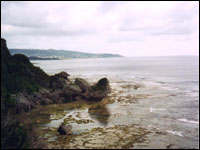Every year, scuba divers make tens of thousands of excursions into the waters off Okinawa, Japan, drawn by the spectacular array of sea life on display. Soon, though, that sea life may be blasted out of the water by an unwelcome sonic barrage.
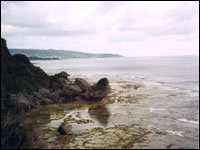
The Okinawan coast is not clear.
Photo: Jeff Shaw.
Almost everywhere in the world except in this patch of ocean, denizens of the deep won a reprieve this month, when a court agreement between environmental organizations and the U.S. Navy limited the military’s use of low-frequency active sonar (LFAS). Experts contend that the sonar, which uses high-intensity bursts of sound to track submarines, is deadly for marine mammals and other sea life. Under the terms of the agreement, use of the technology is now restricted to East Asia, including portions of the Sea of Japan, Philippine Sea, South China Sea, and East China Sea — meaning the Navy may soon visit earsplitting noises on endangered animals in Okinawa’s peaceful waters.
Joel Reynolds, director of the Natural Resources Defense Council’s Marine Mammal Protection Project, calls the recent settlement “a major step forward” toward protecting marine life and a measure of protection “against the proliferation of sonar around the world.” He’s right — but however important the settlement is, it is just a step. And this incomplete victory comes at great cost for threatened species in an ecologically significant part of the world.
The Dugong Show
“The waters off of Okinawa are some of the richest in biodiversity in the world,” says Peter Galvin, Pacific director for the Arizona-based Center for Biological Diversity. “It’s been described as the Galapagos of the East, and it’s under siege.”
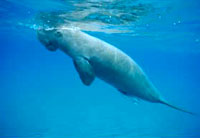
Dugong but not forgotten.
Photo: GBRMPA.
That rhetoric isn’t hyperbole: Okinawa supports a dizzying variety of marine species. The island’s coral reefs rank behind only Australia’s Great Barrier Reef in terms of ecological diversity, sustaining more than 1,000 types of fish and a host of other spectacular wildlife. One prime example is the critically endangered Okinawa dugong, a manatee-like creature that holds a special place in local culture because it is traditionally regarded as a messenger from the sea gods. Only about 50 of these animals remain alive today in the waters off Okinawa. Any new threat could push this unique dugong population over the brink to extinction.
“We’re very concerned about impacts to the fragile dugong population,” Galvin says. “There’s every reason to believe that these sonar impacts are across the marine mammal spectrum. That’s what the science shows.”
While no study has found that low-frequency sonar threatens the dugong particularly, the risks posed by the technology to other marine mammals are well documented. The sonar can boom out a signal reaching 215 decibels — as loud as an F-15 fighter plane at takeoff. In the acoustic environment of the ocean, this deafening roar can cause stress and severe physical harm to sea life, including marine mammals such as the humpback whales that use the East China Sea for breeding and migratory grounds.
Species like whales and dolphins that communicate with sound face a distinct risk, but it’s not just marine mammals that are affected. Compelling evidence shows that sonar can also be deadly for sharks, fish, and endangered sea turtles, at least three species of which exist off the coast of Okinawa.
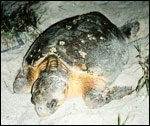
At loggerheads over turtles.
Photo: U.S. FWS.
When U.S. Magistrate Judge Elizabeth Laporte issued the initial injunction prohibiting use of the sonar in October 2002, she cited the threat to turtles specifically. Laporte wrote that “endangered species, such as sea turtles, will … be in LFA sonar’s path” and that the sonar risked causing “irreparable harm to the marine environment that supports the existence of these species.” The hawksbill, loggerhead, and green sea turtle are all included on the United States’ Endangered Species List as well as the global Convention on International Trade in Endangered Species. All are found in Asian waters, and all lay their eggs on Okinawan beaches.
These facts point to one inescapable conclusion: This is not the place to deploy an invasive, noisy, and ecologically devastating technology. “This will affect the wildlife around Okinawa very severely, but it will also affect the entire area, from Indonesia to Sakhalin,” says Chalmers Johnson, head of the Japan Policy Research Institute.
Sacrificial Slam
If these seas are so important and sensitive, why were they chosen as the sacrifice area? The nations whose waters will be affected had no role in the court settlement negotiations. Talks between the Navy and environmental groups “were conducted under a veil of confidentiality,” says Reynolds of NRDC, so it’s impossible to say with certainty how this arrangement was reached.
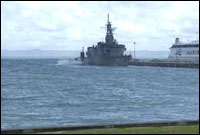
Okinawa’s got the Navy blues.
Photo: U.S. Navy.
It isn’t too hard to make an educated guess, though. Okinawa is already home to a huge U.S. military presence, so making the surrounding seas a training ground is convenient for the Navy. Moreover, because of a vexing dual colonialism, Okinawa is largely powerless to resist.
Though legally part of Japan, Okinawa’s ethnically and culturally distinct people are often looked down upon by mainland Japanese. Okinawa is further politically isolated by its status as Japan’s poorest prefecture and by the lack of a shared history with the rest of the country. (Okinawa’s islands were part of the independent Kingdom of the Ryukyus until they were annexed in the 19th century.)
The U.S. military has been all too willing to exploit Tokyo’s reluctance to stand up for Okinawa. The tiny island chain has been forced to house 75 percent of Japan’s American military bases — though all of the Okinawan islands put together comprise just six-tenths of one percent of Japan’s territory. Okinawa bears the resultant burdens, including pollution on land and at sea.
Johnson, one of the foremost Asia scholars in the U.S., says he isn’t surprised the same technology that raised an outcry when used in Puget Sound is being shipped to the North Pacific instead. “This seems like typical Navy racism,” he says flatly.
Sound Bites
The outcome also raises uncomfortable questions about U.S. environmental groups’ right to decide the fate of Okinawa’s ocean life. If LFAS is a real threat to marine natural resources, as almost every credible scientist seems to believe, then shifting its use to a place most Americans don’t see smacks of environmental racism.
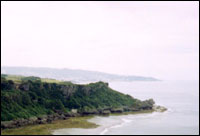
A shore thing.
Photo: Jeff Shaw.
Still, it is difficult to fault NRDC and the five other plaintiffs in the lawsuit for settling; after all, the global environment is better off for it. Indeed, under the settlement agreement, less than 1 percent of the world’s oceans faces the disruption and death caused by LFAS, as opposed to about 75 percent. The settlement also adds seasonal restrictions to sonar tests and limits sonar use near the coastline. “[The plaintiffs] probably thought [the agreement] was the best they could do,” Johnson says. Probably — but the bottom line is that an impoverished and oppressed sea-based culture takes the fall to protect the environment elsewhere.
Moreover, without vigilance, other seas may share East Asia’s burden. Taking advantage of their elevated status in today’s security-conscious environment, the U.S. military is asking Congress to exempt it from the Endangered Species Act and Marine Mammal Protection Act. This legislative end run would circumvent the court’s ruling on sonar and enable what Galvin calls “a full-scale assault on environmental law.”
“The overall context to keep in mind is that the military is trying to exempt itself from these requirements all around,” says Galvin. “The military is talking out of both sides of their mouths, signing this settlement at the same time that they’re asking to be exempted from all environmental protections.”
Facts haven’t gotten in the way of the military’s push. Even former U.S. EPA Administrator Christie Whitman admitted before Congress that she couldn’t come up with one example of environmental regulations that prevented the military from carrying out its duties. Still, Congress is considering granting these wide-ranging exemptions, which would gut two flagship environmental laws and effectively reverse every victory the new settlement secured.
Now is a pivotal time for developing a real solution for seas around Okinawa and the world. The first step is to defeat these exemptions, which Johnson calls “attempts to establish the military as a force beyond the law that can do whatever it damn well pleases.” The second is to prevent Okinawa and the rest of East Asia from becoming the world’s environmental whipping boy.
NRDC, Reynolds promises, “absolutely” plans to reach out to Japanese and Okinawan environmental groups as part of an international effort. If that happens, and this agreement is followed by a policy that protects oceans everywhere — with no exceptions — from acoustic assault, then the work leading up to the settlement will have been worthwhile.
If not, this agreement represents at best a holding pattern, and at worst, a Faustian bargain. If Puget Sound deserves to be free of low-frequency sonar, then so does the East China Sea.
